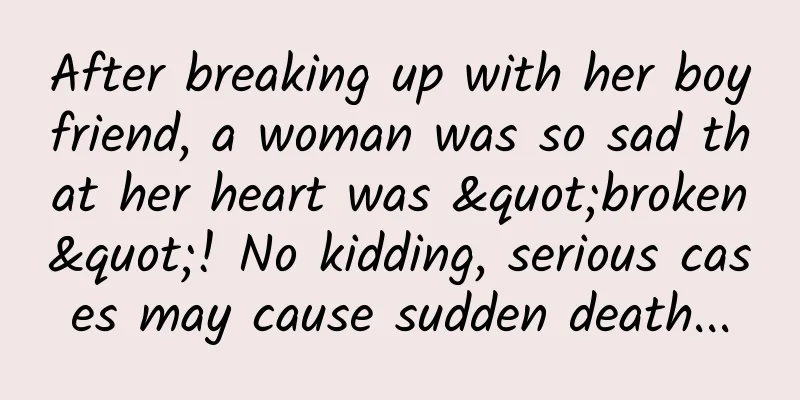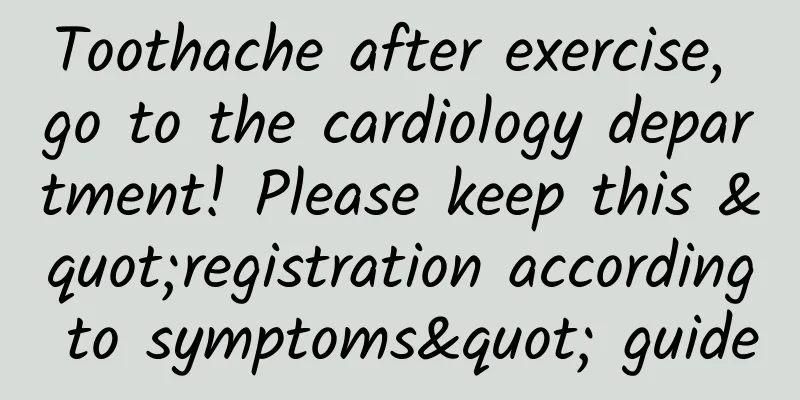After breaking up with her boyfriend, a woman was so sad that her heart was "broken"! No kidding, serious cases may cause sudden death...

|
Expert in this article: Yang Chao, MD, attending physician at the Rocket Force Special Medical Center Reviewer of this article: Chen Haixu, Deputy Director and Master Supervisor of the Second Medical Center of PLA General Hospital "It's so sad, my heart is broken..." Many people often say this when they encounter sad things, often because they feel sad and depressed because of something. But have you ever thought that when you are sad to a certain extent, you may really be "heartbroken". Recently, a woman was very sad after breaking up with her boyfriend. Unexpectedly, she developed chest pain, shortness of breath and other symptoms. After seeing a doctor, the doctor said that the woman's condition was called "broken heart syndrome." Weibo screenshot What is Broken Heart Syndrome? Is the heart really broken? Read on. What is Broken Heart Syndrome? In real life, emotions not only affect people's thinking, but also affect our heart structure. When exposed to great stress such as car accidents, shock, excessive sadness, fear and physical illness, the left ventricle will experience transient segmental myocardial contraction disorders, which we call "broken heart syndrome", also known as stress cardiomyopathy, apical balloon syndrome, Takotsubo syndrome, and octopus pot cardiomyopathy. It was first proposed by Japanese scholar Sato in 1990. Broken heart syndrome is an acute syndrome characterized by transient localized left ventricular systolic dysfunction caused by physical or psychological stress. 17.4 people out of every 100,000 suffer from broken heart syndrome, which is more common in postmenopausal women. The average incidence rate in women is 7.5 times that in men. What are the symptoms of Broken Heart Syndrome? The hearts of patients with broken heart syndrome usually do not have obvious organic lesions such as vascular obstruction, so their hearts are not really "broken", but their signs and symptoms are often similar to those of a heart attack. Doctors generally make a diagnosis through personal medical history and physical examination, electrocardiogram (ECG), echocardiogram, blood myocardial enzyme testing, cardiac magnetic resonance imaging (MRI), coronary angiography and other examinations. Copyright image, no permission to reprint The initial symptoms of broken heart syndrome are similar to those of acute coronary syndrome, generally manifested as severe pain behind the sternum, pressure in the chest area, palpitations, syncope, etc. The symptoms will disappear in most patients within a few weeks. Severe patients may experience pulmonary edema, arrhythmia, or even cardiogenic shock, such as hypotension, cold limbs, dyspnea, and electrocardiogram ST segment changes, but there is no angiographic evidence of obstructive coronary artery disease, and coronary stent placement or surgical bypass surgery is not required. A small number of patients may experience cardiac arrest, respiratory arrest, and sudden death. A study in the Journal of the American Heart Association showed that "broken heart syndrome" not only damages the heart, but may also cause cancer. What factors may trigger broken heart syndrome? ● Emotional stressors: death or injury of relatives or friends, violent quarrels, property loss, legal proceedings, car accidents, etc. ● Physical stressors: severe illness, surgery, severe pain, recovery from general anesthesia, hyperthyroidism, cocaine abuse, etc. Copyright image, no permission to reprint How is Broken Heart Syndrome Treated? There is currently no unified standard treatment for stress cardiomyopathy. The symptoms of broken heart syndrome are similar to those of acute coronary syndrome. Before a clear diagnosis is made, it can be treated according to the treatment of acute coronary syndrome. After the diagnosis is confirmed, the inducing factors should be removed and stress factors should be avoided. The underlying disease should be actively treated and symptomatic supportive treatment should be given. Most patients have a good prognosis and recover within a few days to a few weeks. A few can last for more than 3 months. The in-hospital mortality rate is less than 8%. When we encounter sad things Learn to self-coach Or seek help from others Beware of Broken Heart Syndrome If you experience any discomfort Seek medical attention promptly The cover of this article and the pictures with watermarks in the text are from the copyright library and are not authorized for reproduction |
<<: "Lu Xun withdraws from Chinese textbooks"?
>>: The Earth's "two-faced" inner core rotates faster than the surface
Recommend
What are the medicinal values of white peony?
Speaking of white wormwood, I believe many people...
The efficacy and function of bamboo rat teeth
Bamboo rat teeth are very nutritious and precious...
The efficacy and function of reed flowers
Many people are not very clear about the effects ...
Side effects of Bidens pilosa
Bidens pilosa is a herbaceous food that is common...
Feeding a Tibetan brown bear privately causes it to rush towards tourists? It's really a life-threatening move!
Recently, a video of a Tibetan brown bear chargin...
Food Safety | Acidic foods cause cancer? Alkaline foods are healthier? Don’t be misled by the “acid-base theory”
Acidic foods cause cancer, alkaline foods are hea...
A scientific Chinese New Year | Spring Festival Gala + Technology! Come and watch the Spring Festival Galas in various places and listen to the "gluttonous feast"
Dragons soar and tigers leap, auspicious stars sh...
How difficult is it to softly land on an alien planet?
So far, the list of members of the "Lunar So...
The efficacy and function of Cassia tora
There are so many medicinal herbs in the world, a...
Case solved! The lost brothers were found less than 200 kilometers apart after being separated for 438 million years
Some time ago, the Institute of Vertebrate Paleon...
Night Parade of One Hundred Demons丨What kind of ghost will a person become after he dies?
Qingming Festival is one of the 24 solar terms an...
Can mugwort be used to bathe babies?
Artemisia is a medicinal herb that can clear away...
Medicinal recipes for soup
With the improvement of life, more and more peopl...
In the great era of sculpture with shining stars, he who invented the layered carving technique is the legendary representative
Donatello lived in an era when the Italian Renais...
Why does frostbite recur in winter? How to prevent it? Here is everything you want to know...
Expert of this article: Li Tian, Chief Physicia...









